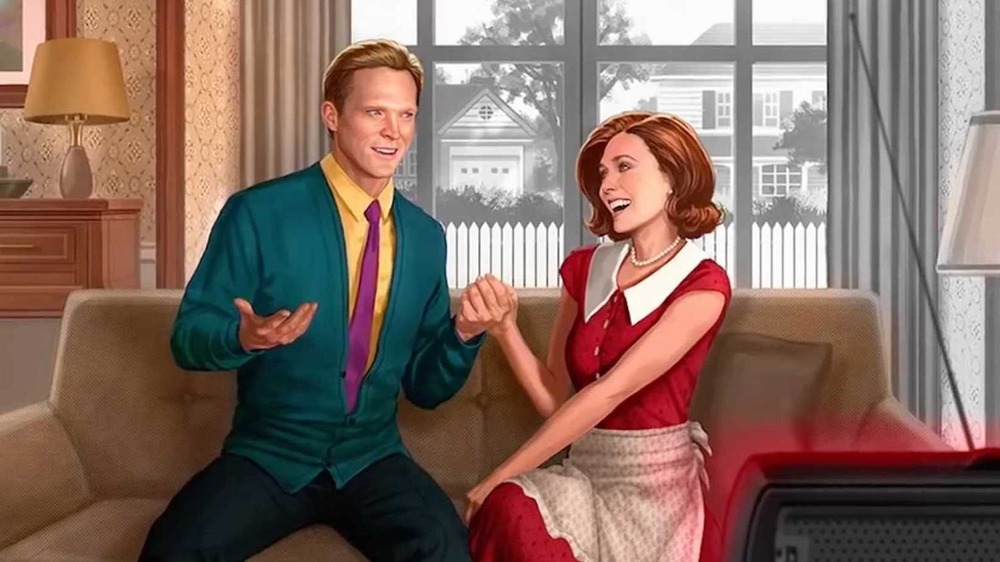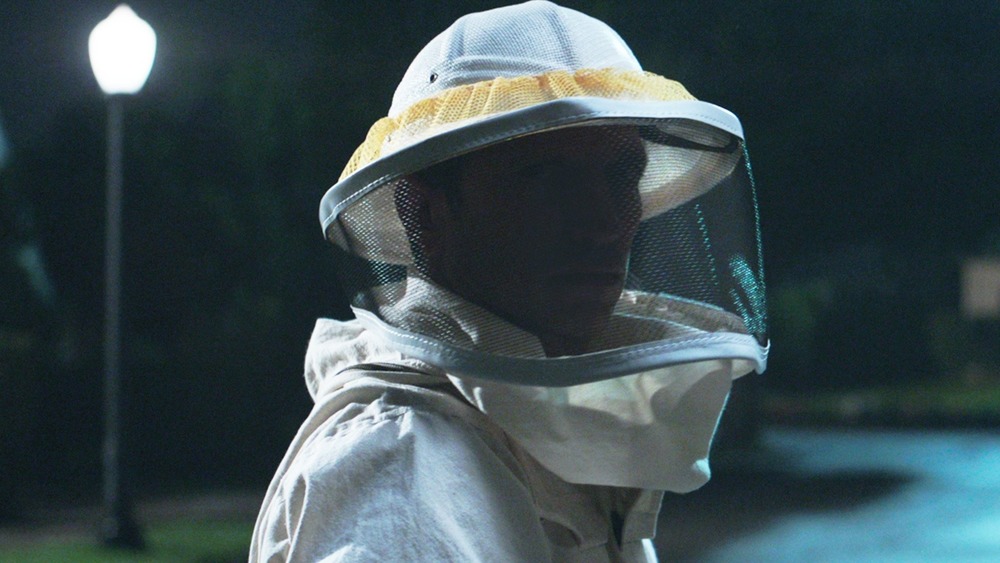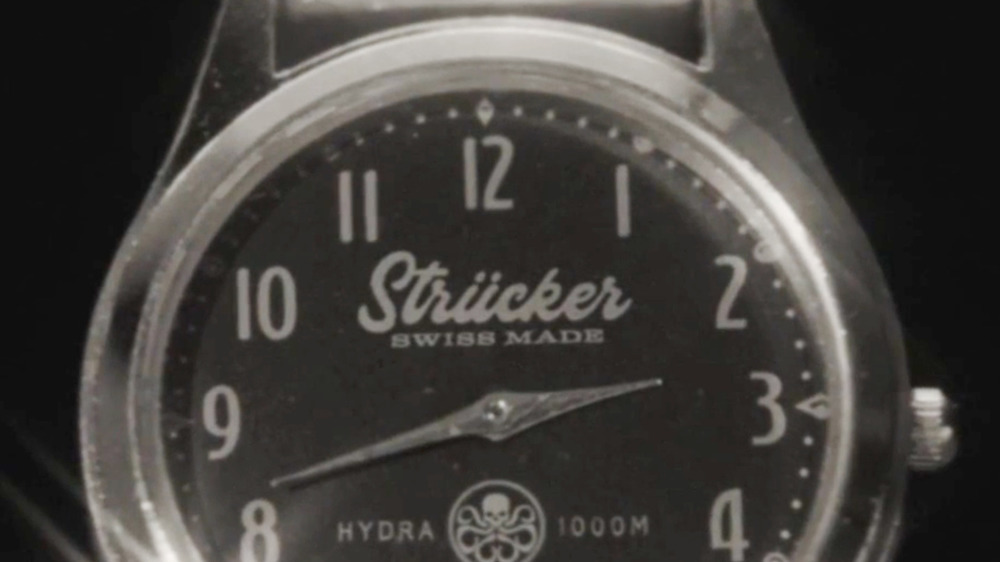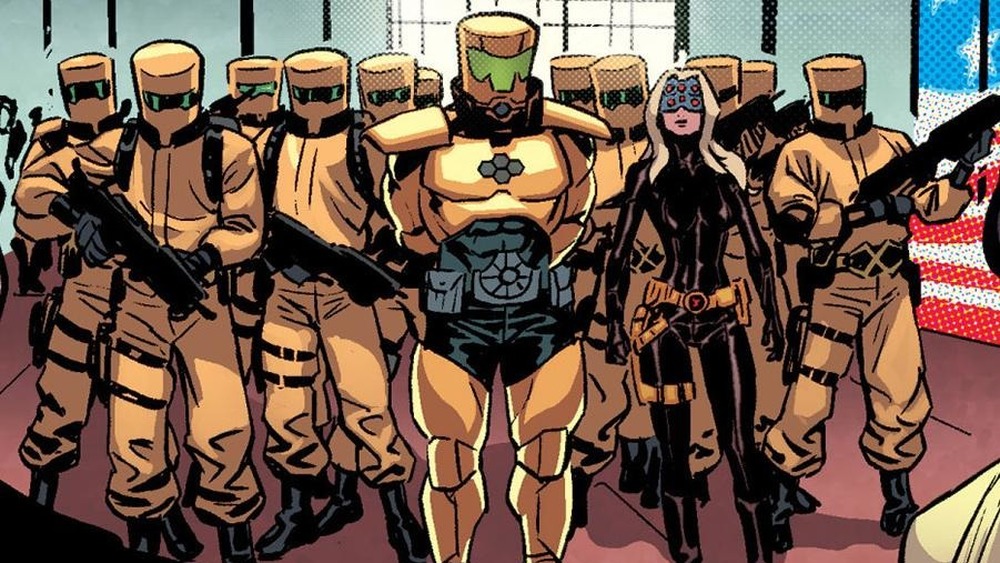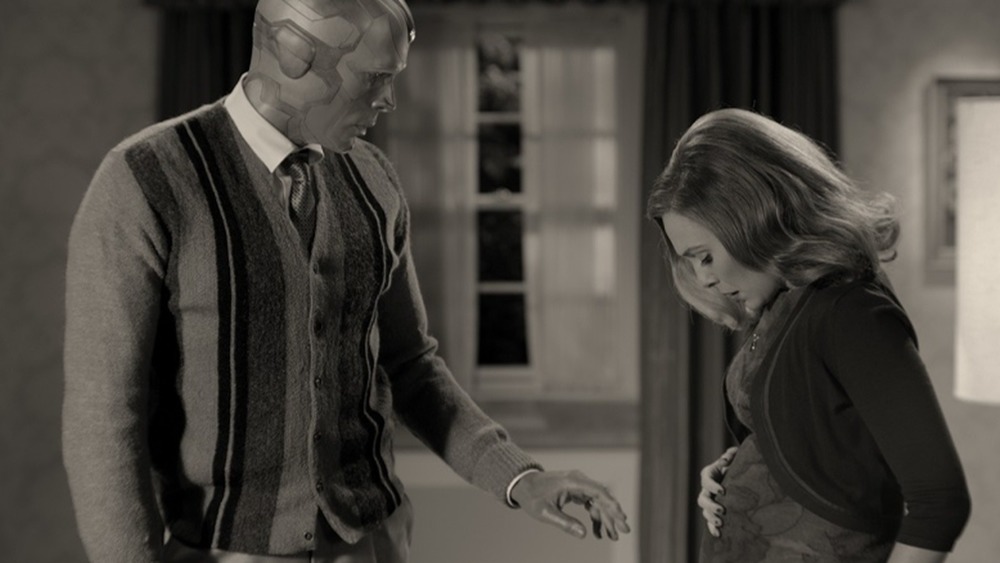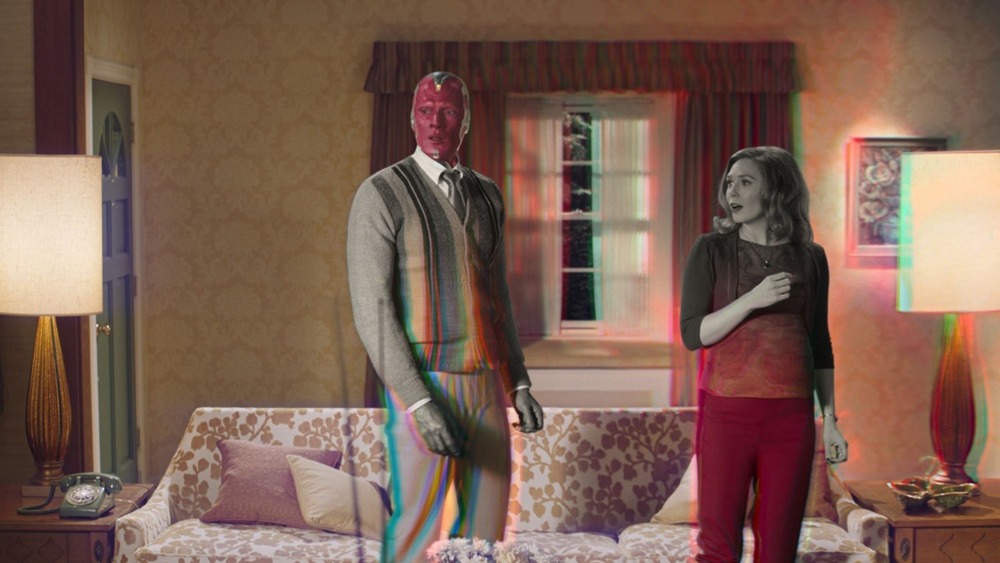WandaVision Episode 2 Ending Explained
Contains spoilers for WandaVision episodes 1 and 2
Following in the footsteps of the Star Wars franchise, the Marvel Cinematic Universe has officially dipped its toe into the Disney+ pool, releasing the first of its many original offerings for the streaming service. Starring Elizabeth Olsen and Paul Bettany as Wanda Maximoff and Vision, respectively, the aptly titled WandaVision made its double-header debut on January 15, 2021.
The series has established its aesthetic as one of mystery and parody, bringing the titular duo to audiences via a slightly off-kilter sitcom format. Right off the bat, the inaugural episode of WandaVision takes its inspiration from television of the 1950s for a seemingly innocent story. Vision, now a straightlaced office worker, hosts his boss, Mr. Hart (Fred Melamed), and his wife (Debra Jo Rupp) to a meal at his and Wanda's suburban residence. Thanks to a small misunderstanding over the date's significance, the two struggle to make the evening go as planned but eventually get everything sorted out and leave their guests impressed. All the while, one can't help but feel as though something is amiss, despite most of the characters going about their lives without a care in the world.
In the spirit of the show's first episode, its successor doesn't shy away from these head-scratching elements, as more and more questions begin to arise. Jumping ahead to the 1960s for episode 2, WandaVision continues to keep up its mildly unnerving, classic-television-inspired façade. Here's where we are at the end of WandaVision episode 2.
S.W.O.R.D. looms large
For as entertaining as WandaVision is proving to be, it's impossible to ignore the fact that the show's very existence goes against the current MCU timeline. Vision is supposed to still be dead after Thanos' (Josh Brolin) forceful removal of the Mind Stone from his head, and Wanda certainly wasn't alive in the 1950s or '60s. The first episode of WandaVision doesn't delve too deeply into what's really going on, but the second ups the ante in a big way, with hints that point out the fragility and fraudulence of this new reality.
Early on in the episode, Wanda takes notice of something sitting in her front-yard bushes: a small toy helicopter with a mysterious sword emblem on its side — which seems like a clear reference to a S.H.I.E.L.D.-like organization in the comics called S.W.O.R.D., but more on that in a moment. That moment passes, and she doesn't think much of the toy helicopter again, but things get stranger from here. During Wanda's meeting with the neighborhood organizer Dottie (Emma Caulfield), a nearby radio begins to speak directly to her — asking, "Wanda? Who's doing this to you, Wanda?" before exploding. Despite her growing anxiety, the odd occurrences don't stop there.
Following her and Vision's successful magic act at the Westview talent show (even in the face of the android's gummed-up circuitry), the two go home, but there's no time for celebration. They're alerted by a loud noise outside, prompting them investigate it in case there's some kind of danger. What they find is a person, wearing a beekeeper suit with plenty of the flying insects buzzing around him, crawling out of a manhole. The man's identity remains unknown, but that same S.W.O.R.D.-looking logo is adorned on the back of his outfit, implying his connection to the group.
So, what is S.W.O.R.D.? In the comics, the acronym stands for Sentient World Observation and Response Department, and it sort of functions similarly to S.H.I.E.L.D, but in space. It made its debut in 2004's Astonishing X-Men #3, written by future MCU heavyweight Joss Whedon. Recently, meanwhile, promotional images for a Topps digital trading card set for WandaVision has been making the rounds on the internet — and one of them features a breakdown of the organization's new acronym: the Sentient Weapon Observation and Response Department.
S.W.O.R.D.'s motives and their connection (or lack thereof) to Wanda and Vision's reality will surely be expanded upon in the coming weeks.
Watch out for Strücker
Midway through WandaVision episode 2, the main action pauses and an in-universe commercial plays. It's one for the Swiss-made, Rolex-like watch company Strücker, whose watches feature ... the HYDRA insignia and name on their faces. That's a clear reference to Marvel's fictional terrorist organization determined to take over the world, but what about the name of the watch company itself? It's also an indisputable nod to established MCU lore: one of the leaders of HYDRA in the films is named Baron Wolfgang von Strucker. Though WandaVision drops the "von" and adds an umlaut to the U in the surname, the pronunciation is the same. Whether the altered spelling is of any significance — perhaps as a subtle way to reaffirm that the reality Wanda is experiencing feels real but actually isn't – remains to be seen, but there's obviously something going on here.
It gets even more interesting when you remember that Baron von Strucker and Wanda have a history — and not a nice one at that. Played in the films by Thomas Kretschmann, von Strucker first appeared in the MCU in Captain America: The Winter Soldier's mid-credits scene, shown celebrating the arrival of the "age of miracles" as he and others in a HYDRA lab examine Loki's scepter and a pair of super-powered test subjects. Those subjects? None other than Pietro and Wanda Maximoff, the only two survivors of the human experiments for which von Strucker ordered Dr. List (Henry Goodman) to recruit. In a way, von Strucker is directly responsible for Wanda's transformation into the Scarlet Witch, and one could even argue that, because of that, he's also responsible for everything that's happened to Wanda post-experiment — including the strange reality she's living in now.
It's also important to note that in the commercial, we hear the Strücker Watches tagline: "Strücker — He'll make time for you." Von Strucker died in Avengers: Age of Ultron, after Ultron murdered him and wrote a message to the Avengers using von Strucker's own blood. One would assume that von Strucker's death in the 2015 movie rules out a return in WandaVision. But, as we know by now, the series isn't abiding by the details of the current MCU timeline. After all, Vision's supposed to be dead, too. There's a very real possibility that future episodes of WandaVision might see von Strucker appear, "making time" to visit Wanda in her uncertain reality for some evil reason.
Short of a legitimate von Strucker return, members of HYDRA could in some way factor into WandaVision. Might they somehow be behind this weird world? Did HYDRA "make time" for Wanda and Vision, and this commercial is being used to signify the outside reality seeping into the possibly fabricated one? It's definitely something worth chewing on.
Something more to the beekeeper?
If beauty is in the eye of the beholder, mystery is in the identity of the beekeeper. The symbol on the back of his uniform appearing to be the logo for S.W.O.R.D. is one thing, and the bees buzzing around the unidentified man are another. They're beyond buzzing, in fact — they're swarming. In the Marvel comics, there's actually a supervillain named Swarm, a former Nazi scientist and beekeeper who combined his consciousness with a colony of mutant bees. He first appeared in 1977's Champions #14.
Swarm has yet to appear in the MCU, but in the comics and in several animated television series, he's a known enemy of Spider-Man. As such, if Swarm is an established Spider-Man baddie, Sony Pictures ostensibly holds the live-action screen rights to the character — but that doesn't rule out the possibility of the WandaVision beekeeper being Swarm himself. Marvel and Sony struck a deal to co-produce the Tom Holland-led Spider-Man movies and make his inclusion in crossover films a possibility, so there's precedent for this. Plus, with the two studios' brief tiff about Spider-Man ownership long behind them, there's a chance that Sony allowed for Marvel to bring Swarm into the MCU via WandaVision.
Another potential — and probably more plausible — explanation for the appearance of the mysterious beekeeper in WandaVision is that he's somehow related to A.I.M., the criminal organization also known as Advanced Idea Mechanics. A.I.M., which first showed up in 1966's Strange Tales #146, was an off-shoot of HYDRA, and its leaders include the android Super-Adaptoid, Bruce Banner's former flame (in the comics) Monica Rappaccini, and M.O.D.O.K., who is set to appear in his own series on Hulu. Other noteworthy members of A.I.M. are Yelena Belova and Taskmaster, two characters who will appear in the upcoming Black Widow solo movie. Of course, Baron von Strucker was a part of A.I.M. as well. In the comics, he's the founder of the organization, but in the MCU, Iron Man 3 establishes that Aldrich Killian — aka the Mandarin — created A.I.M. In May 2019, Marvel boss Kevin Feige teased that the MCU would bring the "real Mandarin" into the mix in the future, and we all know how much Marvel loves to link together all its properties through subtle details, so perhaps there's some sort of connection here.
Now, while leaders of the organization dress in business attire, other A.I.M. operatives and technicians sport uniforms and helmets that resemble beekeepers' gear, much like the anonymous man's uniform as seen at the end of WandaVision's second episode. In the comics, A.I.M. members wear yellow uniforms, but in Iron Man 3, they don't — another piece of evidence to back up the idea of the WandaVision beekeeper being an A.I.M. member. On top of that, with the reference to HYDRA in the Strücker Watches commercial, it appears that HYDRA could be influencing Wanda and Vision's life in some way. Thus, it makes more sense that the beekeeper could be a member of the HYDRA branch A.I.M. rather than an unrelated supervillain, despite their bee-centric similarities. All in all, we are buzzing with confusion.
Baby fever
Early on in WandaVision's first episode, Wanda makes it known that she wants more than anything to fit in with her and Vision's new community. She's aware that they're out of place in the neighborhood — since she's a super-powered reality-manipulator and he's an android — and certainly doesn't want to draw any attention if she can help it. As if that wasn't difficult enough, the societal pressures of mid-20th-century America quickly start bearing down on Wanda, particularly the expectation that she and Vision will expand their family.
This subplot begins during Wanda and Vision's dinner with the Harts, as Mrs. Hart unleashes a barrage of questions upon the two that includes why they have yet to raise any children. WandaVision episode 2 continues this plot line in a big way, first alluding to the importance of kids in their community through the local talent show containing the tagline "For the Children." The residents' repetition of that mantra in a cult-like fashion throughout the episode drives the point home that Wanda and Vision are behind the social curve.
Thankfully, Wanda's worry quickly disappears not long after the talent show wraps up. In the episode's closing moments, she reveals a brand-new baby bump, apparently and suddenly quite pregnant. Vision appears supportive, and Wanda is obviously excited, but given how uncertain this TV-influenced dimension is, one has to wonder if her pregnancy is just another figment of her — or someone else's — imagination or actually something real. In the comics, Wanda and Vision do have children: Thomas and William, who are twins just like Wanda and her brother Pietro (aka Quicksilver) are. With Vision being an android, though, Wanda had to use her superhuman powers to conceive her sons ... which leads to a heartbreaking revelation in 1989's Avengers West Coast #51 about what Thomas and William are within Wanda's world. Simply put: They're not real. That comic book detail should certainly take on some particular significance when you think about Wanda and Vision reassuring each other that her sudden pregnancy is "really happening." Y'know ... because it's probably not.
Ultimately, however, comics being what they are, the two boys end up being real after all, and go on to become teen superheroes themselves. Thomas, now going by "Tommy," is the lightning-fast Young Avengers member Speed. William, aka "Billy," is also a member of the Young Avengers — a hero called Wiccan who possesses magical and telepathic powers, the ability to bend reality and control others' minds, the power of flight, and more.
Only time will tell if WandaVision sticks to what happens in the comics, or creates a new narrative for Wanda and Vision's children.
In living color
A striking difference between WandaVision and the rest of the MCU up to this point is the use of a black-and-white filter, as seen in the first two episodes. To perfectly capture the 1950s sitcom look, the series' premiere episode lacks any color apart from the light on the toaster that blinks red, and the second episode follows suit to deliver an authentic early-1960s television feel. However, as the latter progresses, it becomes increasingly apparent that more color is on the way — with potentially important implications.
Wanda is the first character to encounter non-black-and-white shades when she investigates the odd miniature helicopter that lands on her property. Since it sports a bright red-and-yellow paint job, the toy immediately stands out to Wanda in this monochromatic world, implying that she sees her surroundings in that palette only. Later on, after the detonation of the talking radio, Dottie's glass shatters in her hand, resulting in an open wound on her palm spilling crimson blood. From there, the episode remains devoid of color until the very end.
To erase their unsettling encounter with the figure in the beekeeper suit, Wanda rewinds everything to bring herself and Vision back inside, and the two go on as if the moment never happened. However, they notice that all colors of the rainbow are starting to seep into their house. How this is happening remains a mystery, but it certainly fits with WandaVision's trend of replicating television history, as full-color TV became the norm in the mid-1960s. At the same time, it's worth pondering if the appearance of a S.W.O.R.D. operative influenced Wanda — or whoever else is pulling the strings, to alter reality in such a way — and if so, why?
The fact that Wanda herself rewinds time when she sees something she doesn't like seems to be a clear sign that she's much more in control of what's going on than even she may realize, so the world's subsequent colorization would probably be her doing as well. However, the voices coming through the radio, the S.W.O.R.D.-adorned operative, and the mysterious person watching her and Vision at the end of episode 1 all could indicate that she's being manipulated, too.
With seven more episodes incoming, WandaVision will inevitably answer these burning questions one by one. Although, it's entirely likely things will get more convoluted before we see any resolution.
